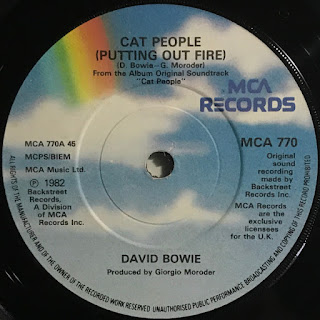DAVID BOWIE - CAT PEOPLE (PUTTING OUT FIRE)
Publicació: 12 de març de 1982
Llistes: Regne Unit: #26 · Estats Units: #67
“Cat People (Putting Out Fire)” és una de les cançons més poderoses i atmosfèriques de David Bowie dels anys vuitanta—una peça lenta i penetrant, plena de tensió cinematogràfica, desig i perill latent. Composada com a tema principal per al remake eròtic i de terror de Paul Schrader, “Cat People” el 1982, la cançó va unir Bowie amb el llegendari productor italià Giorgio Moroder, donant com a resultat un tema fosc, dominat per sintetitzadors, que es convertiria en un èxit comercial sorprenent.
La col·laboració es va iniciar quan Schrader, que ja treballava amb Moroder en la banda sonora, va demanar a Bowie que hi posés veu i lletra. Bowie va volar a Mountain Studios, a Montreux (Suïssa), el juliol de 1981. Segons Moroder, la gravació va ser ràpida i eficient—només dues o tres preses. Tot i la seva imatge d’icona extraterrestre, Moroder recorda un Bowie professional i puntual, que arribava a primera hora per esmorzar i treballava amb discreta eficàcia.
La lletra capta a la perfecció l’essència del film—una història eròtica de metamorfosi, on una família està maleïda a transformar-se en panteres quan s’exciten sexualment. Bowie canalitza el mite antic i la fúria primitiva amb versos com: “See these eyes so green / I can stare for a thousand years”, i la tornada inquietant i icònica: “Putting out fire with gasoline”.
La cançó es va publicar al març del 1982 a través de MCA Records, arribant al número 67 del Billboard Hot 100 als EUA i al 26 al Regne Unit, però assolint el número 1 a Nova Zelanda, Suècia, Noruega i Finlàndia. Va esdevenir el seu major èxit als Estats Units des de Golden Years el 1976. Els crítics van elogiar-ne la producció cinematogràfica i la interpretació esgarrifosa, i la peça va transcendendir el film, apareixent en nombroses bandes sonores i recopilatoris—el més destacat, “Inglourious Basterds” de Quentin Tarantino, on acompanya una de les escenes més intenses del film.
Tot i l’èxit, Bowie mai no va quedar satisfet amb la versió de Moroder. Anys després, admetria que el tema no feia el conjur màgic que ell imaginava per la lletra. Així que el desembre de 1982, durant les sessions de l’àlbum “Let’s Dance”, Bowie la va regravar amb Nile Rodgers com a productor als Power Station Studios de Nova York. Aquesta nova versió comptava amb la guitarra principal de Stevie Ray Vaughan i optava per un estil molt més blues-rock, deixant enrere el sintetitzador per una sonoritat més agressiva i directa.
Rodgers recorda que Bowie li va fer escoltar la maqueta original i li va expressar el seu desencís amb la versió final inclosa a la banda sonora. Tot i mantenir la mateixa línia vocal, la nova versió era més ràpida i menys misteriosa. Curiosament, la segona estrofa (“Feel my blood enraged”) es va eliminar, cosa que alterava la dinàmica emocional del tema.
Tot i aparèixer a l’àlbum supervendes del 1983 “Let’s Dance”., molts fans i crítics consideren que la versió original de Moroder és la definitiva, per la seva textura fosca i el seu ritme lent i carregat de tensió, que reflecteixen millor la temàtica inquietant de la peça. Aquesta preferència queda palesa en recopilatoris com “Bowie: The Singles 1969–1993” (edició EUA), tot i que, curiosament, no s’inclou en l’equivalent britànic “The Singles Collection”.
DAVID BOWIE - CAT PEOPLE (PUTTING OUT FIRE)
Released: March 12, 1982
Charts: UK: #26 US: #67
“Cat People (Putting Out Fire)” is one of David Bowie’s most powerful and atmospheric tracks of the 1980s—a smoldering, slow-burn anthem built on menace, desire, and cinematic tension. Originally recorded as the title theme for Paul Schrader’s 1982 erotic horror remake “Cat People”, the song brought Bowie together with legendary Italian producer Giorgio Moroder, resulting in a dark, synth-driven track that became a surprising commercial hit.
The collaboration came after Schrader, already working with Moroder on the soundtrack, asked Bowie to contribute vocals and lyrics. Bowie flew to Mountain Studios in Montreux, Switzerland in July 1981, where the track came together quickly—two or three takes, according to Moroder. Despite Bowie’s outer-space persona, Moroder recalled that Bowie was “a consummate professional”, arriving early for breakfast and wrapping the session with quiet efficiency.
Lyrically, Bowie captured the film’s erotic, shape-shifting core: a tale of a family cursed to transform into panthers when sexually aroused. His lyrics evoke both ancient myth and primal fury—“See these eyes so green / I can stare for a thousand years”—while the haunting refrain “Putting out fire with gasoline” became instantly iconic.
Released in March 1982 via MCA Records, “Cat People” charted in the UK and US, reaching #67 on the Billboard Hot 100 but soaring to #1 in New Zealand, Sweden, Norway, and Finland. It became Bowie’s biggest solo American hit since “Golden Years” in 1976. Critics hailed the track’s cinematic scope and chilling delivery, and it quickly found life beyond the film, appearing in soundtracks and compilations—most notably in Quentin Tarantino’s 2009 “Inglourious Basterds”, where it underscored one of the film’s most intense scenes.
But Bowie himself was dissatisfied with Moroder’s version. He later claimed the original backing track “didn’t weave the magic spell” he imagined for the lyrics. So, during the sessions for his album, “Let’s Dance”, Bowie re-recorded the song with producer Nile Rodgers at The Power Station in New York City in December 1982. The new version featured Stevie Ray Vaughan on lead guitar and leaned heavily into blues-rock territory. Rodgers later recalled Bowie playing him the original demo and expressing disappointment with the finished soundtrack cut. The re-recorded version kept the same vocal phrasing but offered a more aggressive, streamlined sound. It was faster, leaner, and less surreal—but lacked the haunting mystique of the original.
Significantly, the second verse (“Feel my blood enraged”) was omitted in the new version, altering the emotional structure of the track. Though the remake found a home on Bowie’s blockbuster 1983 album “Let’s Dance”, many fans and critics regard the original Moroder-produced version as the definitive take—its dark textures and smoldering tempo more aligned with the song’s unsettling themes. This preference is reflected in its inclusion on compilations such as “Bowie: The Singles 1969–1993” (US only), though curiously not on the UK’s “The Singles Collection”.









Cap comentari:
Publica un comentari a l'entrada